Click on each image for more information, or scroll through.

GREAT TIT FLEDGLING
I came across this young great tit on a warm day in June, fluttering around in a hedge next to a green lane in my home village of Shelf. It clearly hadn’t been out of the nest long, and was making its first tentative forays into the big, wide world. In the middle of a pandemic, I was touched by its air of brave, bright-eyed optimism.
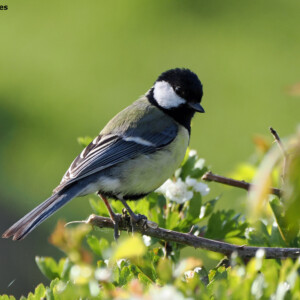
GREAT TIT IN SPRING HAWTHORN TREE
Here’s another great tit – an adult this time – perching next to hawthorn blossom on a bright spring day.
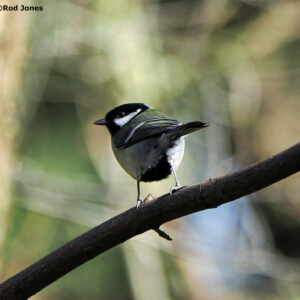
GREAT TIT LOOKING OVER SHOULDER
I snapped this great tit a split-second before it flew off from its perch in our local woods.
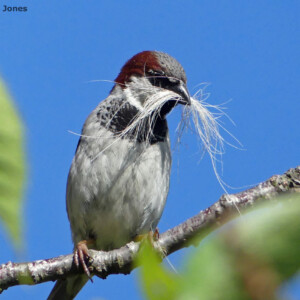
MALE HOUSE SPARROW WITH “MOUSTACHE.”
Sometimes you don’t have to travel very far to capture an entertaining wildlife experience.
This male house sparrow was perched in a tree a few paces from our front door in late June.
He was sporting what appeared to be an impressive white moustache – actually made up of strands of animal hair which he was collecting to line his nest.
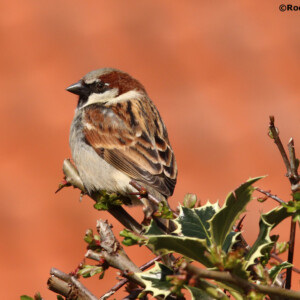
MALE HOUSE SPARROW IN HOLLY BUSH
A red background – a house roof – helps to make this male house sparrow’s colours “pop” as he perches in a holly bush near the Pocklington Canal.
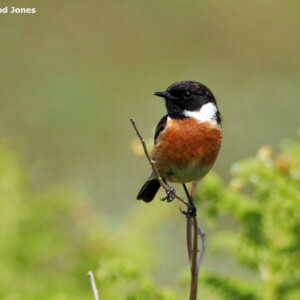
MALE STONECHAT CLINGING TO STALK
Stonechats are bright, animated little birds with a rather endearing habit of giving away their location by uttering a loud call that sounds like two stones being tapped together.
This male was putting on a bit of a show on a warm late spring day on moorland near Todmorden.
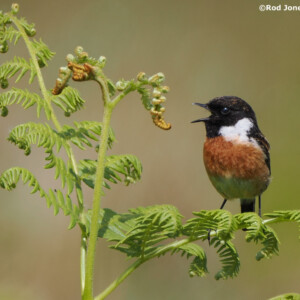
MALE STONECHAT CALLING NEXT TO FERN
Here’s the same male stonechat, calling while perching on a fern.
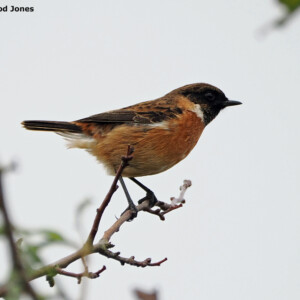
MALE STONECHAT AGAINST WHITE SKY
This male stonechat brightened up a dull autumn day at North Cave Wetlands.

LITTLE OWL ON MOSSY BRANCH
Little owls blend into tree trunks so well, I often only spot them as they’re taking flight. Fortunately, this bird only flew a short distance before landing on a branch and having a good look at me.
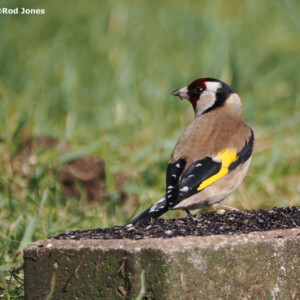
GOLDFINCH EATING NYJER SEED
Goldfinches look as though they really should be rare. Surely that exotic plumage – with daubs of scarlet, primrose, black, white and gingery-brown – shouldn’t belong on a common or garden bird? In fact, I see them on most of my walks around our local fields and woods. Often, it’s a snatched glimpse of a twittering flock, or charm, flitting between the treetops. They’re also frequent visitors to our RSPB twite feeding stations in the Pennines – like this one on a sunny day in early March.
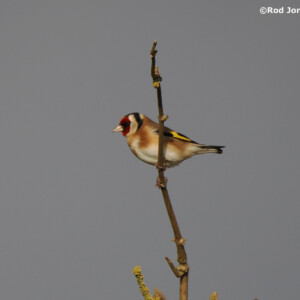
The bright colours of this goldfinch stand out vividly against the dark grey sky on a late December day at North Cave Wetlands.
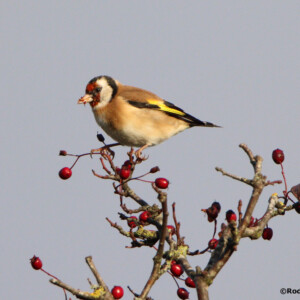
GOLDFINCH EATING BERRIES IN HAWTHORN TREE
This goldfinch is enjoying a feast of hawthorn berries on a bright autumn day – you can see the bright red juice staining its beak.
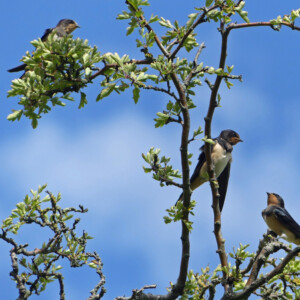
SWALLOWS – THREE IN A ROW
This isn’t a tremendously original thought, but I always welcome the arrival of swallows in our local fields as a sign that summer is on its way. They spend the next five months hurtling at crazy speeds a few inches off the ground in search of insects, like fighter jets on some death-defying low-flying mission, and then by mid-September they’re off on their return flight to Africa. This picture was taken on a gorgeously sunny day in August. I like the bright colours, the symmetry, and the way the birds are looking at each other.
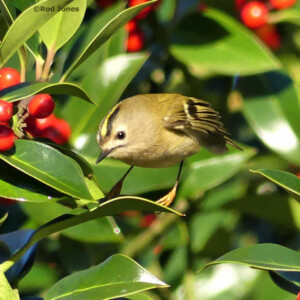
GOLDCREST BALANCING ON A HOLLY LEAF
There’s something magical, almost fairy-like about goldcrests, with their miniature, bright-eyed beauty and their tiny, golden crowns. As this picture shows, balancing on a leaf is easy when you weigh the same as a 20p piece and are just three and a half inches long. They’re the UK’s smallest birds and photographing them is a challenge, even though they’re pretty common. This one was darting about among the bright red berries and waxy green leaves of a holly tree on our local farm track in January.
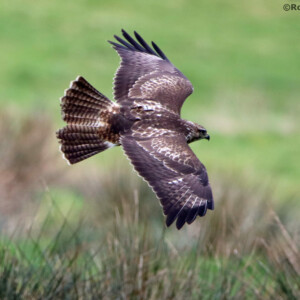
BUZZARD FLYING OVER FIELD
Not surprisingly, most shots of birds of prey in flight are taken from below. I like this shot of a buzzard because I took it from higher ground looking down, giving you a view of the bird’s magnificent wing plumage from above.
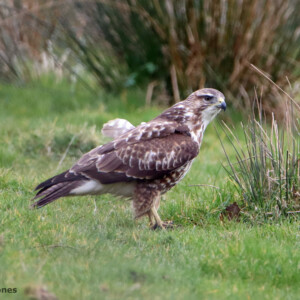
BUZZARD LOOKING ALERT IN FIELD
Here’s the same buzzard on the ground, a few moments before taking flight.
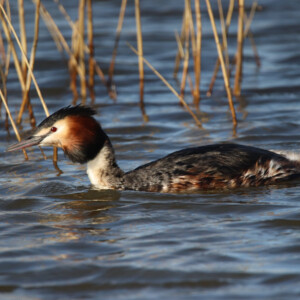
GREAT CRESTED GREBE SWIMMING AMONG REEDS
Great crested grebes are elegance personified, as they glide serenely across lakes and ponds.
Here’s one – just developing its magnificent breeding plumage – on a late February day at St Aidan’s.
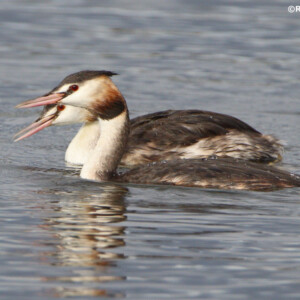
JUVENILE GREAT CRESTED GREBE PEEPING BEHIND PARENT
This photo shows a bit of family togetherness – a young great crested grebe swimming close to its parent at RSPB St Aidan’s.

DUNNOCK CLOSE-UP
There are some moments when nature unexpectedly takes your breath away. Seeing a common-or-garden bird really close-up can be one of those.
This dunnock perched on the roof just a few feet from my open window – giving me the perfect opportunity to get a close-up shot of its intricate patchwork of feathers.
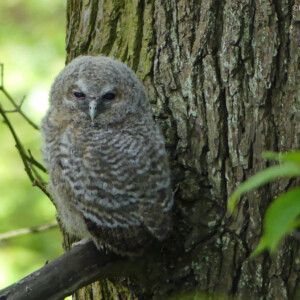
TAWNY OWLET
I was walking through our local woods in mid-May when I spotted something next to a tree trunk. At first I thought it was a fungus, then a grey squirrel, then I realised it was a baby tawny owl.
I kept a safe distance to avoid disturbing it – and it fell asleep while I was taking photos.
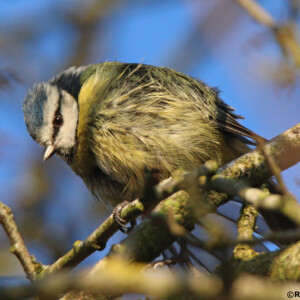
BLUE TIT IN MID-PREEN
This blue tit looks a bit dishevelled. That’s because I interrupted it while it was enjoying a good preening session in our local woods. It paused to have a good look at me before continuing with its beauty regime.
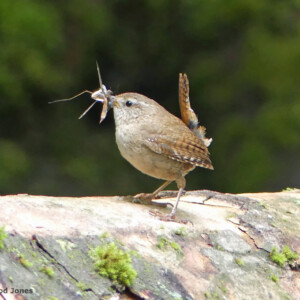
WREN WITH CRANE FLY
Wrens are the UK’s commonest breeding birds, but you wouldn’t think so from my sightings as I walk round my local woods and fields in Halifax. When I see them, they’re invariably little brown shapes pottering around in the undergrowth. So this shot – in Shelf Hall Park in June – is a bit of a triumph for me. Not only is this wren proudly displaying the crane fly it’s just grabbed – it’s also showing off a photogenic upturned tail.
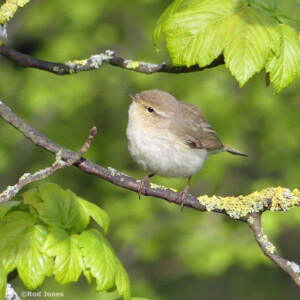
CHIFFCHAFF IN SYCAMORE TREE
Chiffchaffs are easier to hear than they are to see. It’s always handy to have a bird that advertises its presence by shouting its own name – and these little leaf warblers are called after their repetitive song, which echoes through woodland in spring and summer.
They spend a lot of time flitting about at the top of trees – but this one came down a bit lower, posing nicely in a frame of sycamore leaves.
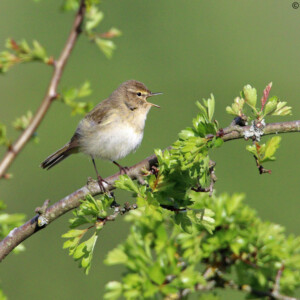
CHIFFCHAFF SINGING IN HAWTHORN TREE
Here’s another chiffchaff, belting out its song in April among the vivid green leaves of a hawthorn tree.
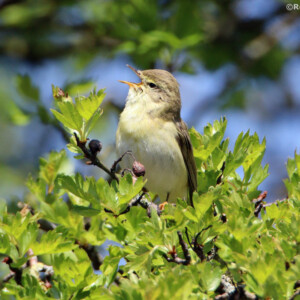
WILLOW WARBLER SINGING IN TREETOP
Willow warblers look very similar to chiffchaffs, but their songs are completely different.
This one was blasting out a tune in late April in a treetop just a couple of metres from one of the main roads over the Pennines. It seemed totally oblivious to the traffic thundering past its perch.
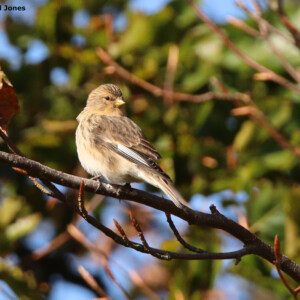
TWITE IN AUTUMN SUNLIGHT
Twites are in desperate trouble. The number of breeding pairs of these finches in England dropped by an alarming 72% between 1999 and 2013.
I’m volunteering on an RSPB project to try to boost their numbers by monitoring them and setting up feeding stations in the high Pennines.

HERON HUNTING AMONG REEDS
This heron seemed completely unconcerned by my presence as it carried on hunting on the edge of a reedbed a few metres away from me at RSPB St Aidan’s. Just look at that gorgeous neck plumage…and that fearsome beak.
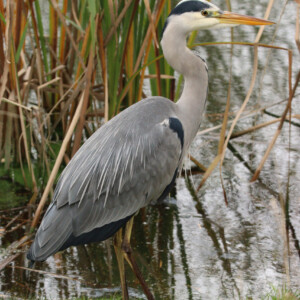
HERON SHOWING BACK PLUMAGE
Here’s the same heron, again completely unfazed by my presence, and displaying its exquisite back plumage this time.
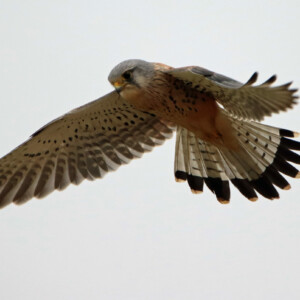
MALE KESTREL HOVERING
A hovering kestrel is a wonderful sight. It can hang in the air, using its tail like a rudder while scanning the ground below for voles.
I now spot them occasionally in our local fields and woods after years when they were nowhere to be seen. They’re more common at RSPB St Aidan’s, where this photo was taken.
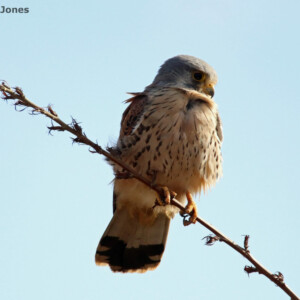
MALE KESTREL WITH FEATHERS RUFFLED BY THE WIND
Here’s another male kestrel at St Aidan’s.
This one took a break from hunting to swoop down onto a perch, giving me the chance to get some shots of its magnificent plumage being ruffled by the wind.
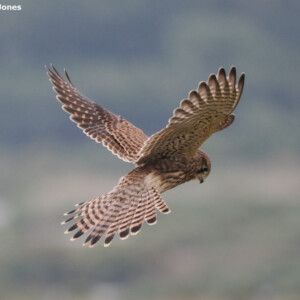
FEMALE KESTREL HOVERING
Here’s another kestrel – a female this time – hovering over a field at RSPB St Aidan’s, looking for voles.
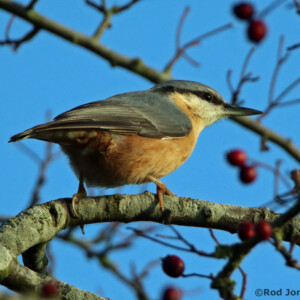
NUTHATCH IN HAWTHORN TREE
Nuthatches are agile birds that are always on the go. That makes them quite hard to photograph, and most of my shots of them have been taken around the bird feeders at Cromwell Bottom nature reserve.
This is a more “natural” image, taken in gorgeous morning sunshine in November in a hawthorn tree on the farm track leading down to Shelf Woods.
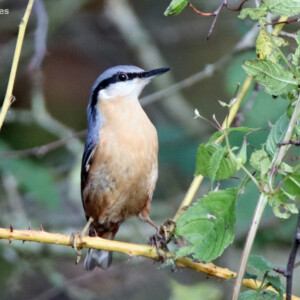
NUTHATCH STANDING UPRIGHT
This nuthatch is adopting a more upright stance – on a thorny branch in our local woods.
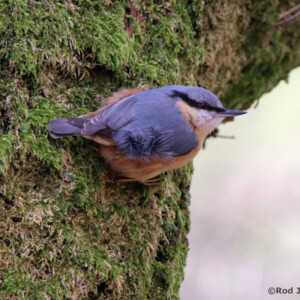
NUTHATCH WITH RUFFLED FEATHERS
This nuthatch – in my local woods in early spring – looks a little dishevelled, but the mossy green background shows off its beautiful colours nicely.
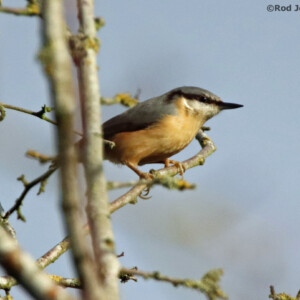
NUTHATCH LOOKING OUT FROM TREE
This nuthatch appears to be acting as a lookout – although it was actually only perched on the edge of this tree for a few seconds before flying off elsewhere.
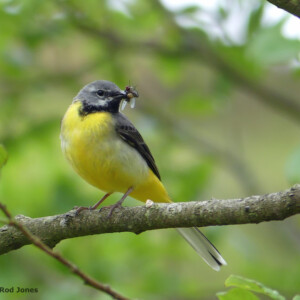
GREY WAGTAIL WITH LUNCH
Grey wagtails sound as if they ought to be a bit dull and dowdy, but their lemon yellow breasts actually make them quite stunning. They’re always on the go, dashing about in pursuit of insects, bobbing their long tails for balance. I sometimes see them flitting across the compost heap at a local farm, but this picture was taken on a summer morning next to the fast-flowing stream that tumbles down from Ovenden Moor to Ogden Water in Halifax.
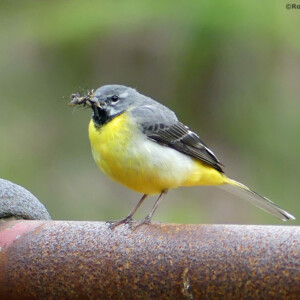
GREY WAGTAIL ON RUSTY BRIDGE
Here’s another shot of the grey wagtail at Ogden Water. This bird was what seasoned birdwatchers like to call “very confiding,” and let me photograph it for several minutes as it perched with its catch on a rusty iron bridge rail.

ELEGANT MUTE SWAN
Mute swans, with their snow white plumage, graceful necks and strikingly-marked bills, are traditional symbols of beauty. There’s also a hint of menace about them, and I think this swan’s expression conveys that quite well. The photo was taken on an early autumn day on one of the lakes at RSPB St Aidan’s near Leeds.
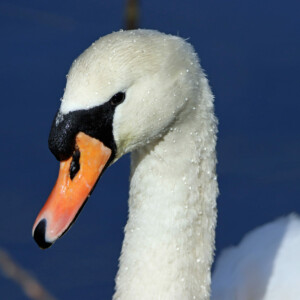
MUTE SWAN WITH WATER DROPLETS
This swan had been feeding under water at one of the lakes on Hatfield Moor – and you can see the droplets glistening on its head and neck.
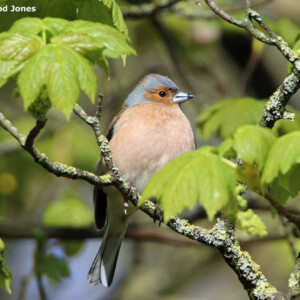
MALE CHAFFINCH FRAMED BY SPRING LEAVES
An over-zealous twitcher once bored my late, much-missed Dad with a monologue about all the rare and exotic species he’d seen. My Dad responded by telling him how much he liked chaffinches.
They may be common, but they’re beautifully coloured. Here’s a male surrounded by fresh spring leaves in our local woods.
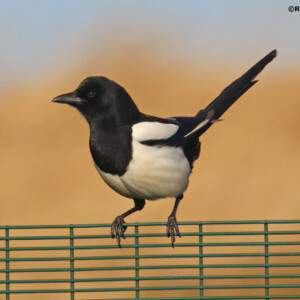
MAGPIE ON GOLDEN MOORLAND
Magpies aren’t universally popular – they’re sometimes viewed as strutting bullies. They can look striking if you catch them in the right light, though. This one was perching against a backdrop of golden moorland while I was monitoring twite for the RSPB in the high Pennines.
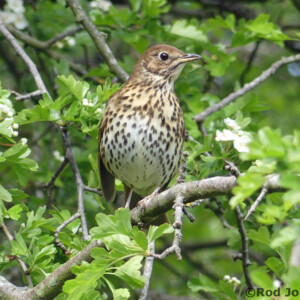
SONG THRUSH IN SPRING HAWTHORN
May is one of my favourite months in Shelf Woods, and hawthorn – with its profusion of delicate white flowers and vivid green leaves – is one of the plants that embody its feelings of hope and new life. It’s even better when it’s being used as a perch by a daintily beautiful song thrush.
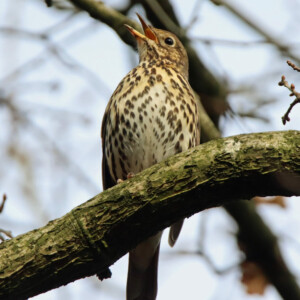
SONG THRUSH SINGING ON BRANCH
Here’s another song thrush, demonstrating the wonderful singing ability that gives it its name. This one was filling our local park with beautiful melodies in mid-February – a welcome foretaste of spring.
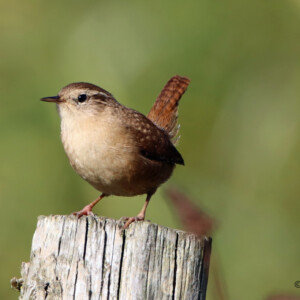
WREN IN SUNLIGHT
This was one of those rare and happy occasions when a shy bird steps out of the shadows and into the spotlight.
I was walking along a wooded path at Rodley Nature Reserve on an autumn afternoon when this wren hopped onto a post in gorgeous sunlight and posed perfectly for the camera.
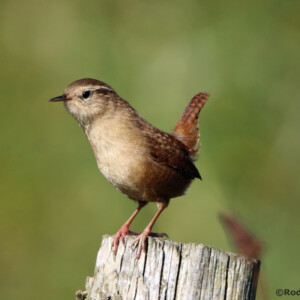
WREN LOOKING INQUISITIVE
Here’s another shot of the same wren, looking very interested in what’s going on around it.
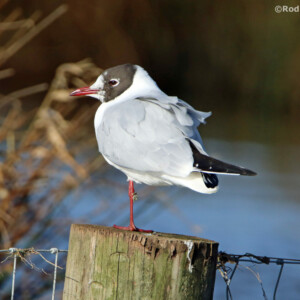
MEDITERRANEAN GULL STANDING ON ONE LEG
This gull caught my eye by balancing nonchalantly on one leg despite a stiff wind that ruffled its feathers on a late winter day at RSPB St Aidan’s.
It’s a Mediterranean gull – rarer and slightly bigger than a black headed gull, distinguished by its bright red beak and white wing-tips and underwings.
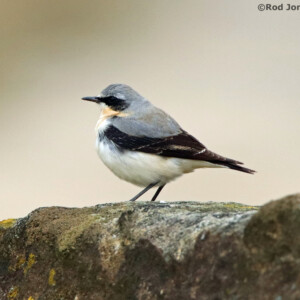
MALE WHEATEAR PERCHING ON ROCK
Male wheatears are handsome birds with a distinctive black “bandit” mask.
They spend the winter in central Africa and return to the UK in March as a welcome sign of spring – like this one perching on a rock in the high Pennines.
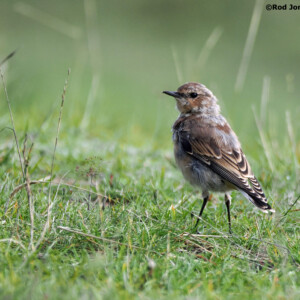
JUVENILE WHEATEAR AMONG LONG GRASS
This is a juvenile wheatear in the long grass near Green Withens Reservoir in the high Pennines. It’s late July, and this youngster’s feathers are still fluffy and patchy. It’s amazing to think that, just a few weeks later, it’ll be depending on them when it makes the long journey south to Africa.
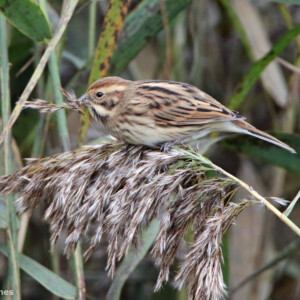
FEMALE REED BUNTING EATING SEEDS
Reed beds are a great habitat for wildlife, and there are plenty of them at Rodley Nature Reserve on the outskirts of Leeds.
Here’s a female reed bunting balancing on a reed while feeding on autumn seeds.
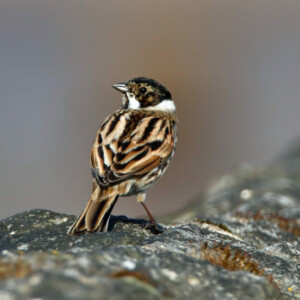
MALE REED BUNTING PERCHING ON WALL
Here’s another reed bunting – a strikingly-marked male this time – perching on a reservoir wall in the high Pennines.
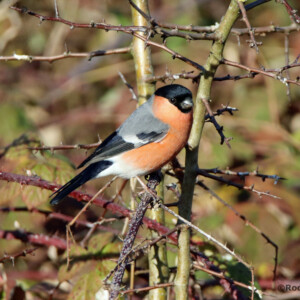
MALE BULLFINCH AMONG PRICKLY BRANCHES
Bullfinches’ character doesn’t match their name or their appearance. They’re sturdily-built birds with bold markings – pinky-red in the males and brown in the females. But they’re fairly elusive, and often hide among the trees.
Their whistling call is usually the first sign that they’re around – as with this gorgeous male at North Cave Wetlands.
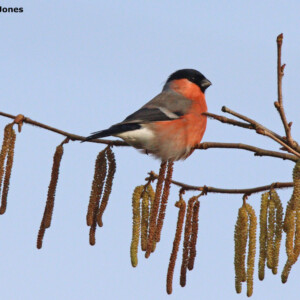
MALE BULLFINCH AND CATKINS
Here’s another male bullfinch. It’s a bright day in mid-February and this handsome bird is perching next to the catkins at Rodley Nature Reserve.
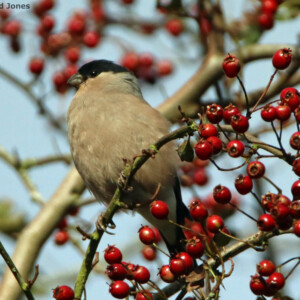
FEMALE BULLFINCH AMONG HAWTHORN BERRIES
Female bullfinches are beautiful in a slightly less showy way than their gaudily-marked male counterparts.
This one was enjoying the autumnal feast of berries at the top of a hawthorn tree in one of the quieter parts of our local woods.
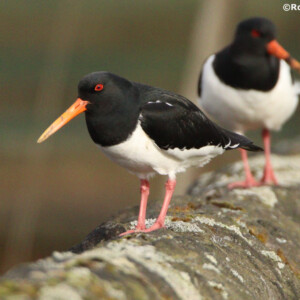
OYSTERCATCHERS ON RESERVOIR WALL
One of the many benefits of volunteering on the RSPB’s twite recovery project is that it gives me the chance to spot other wildlife in the Pennine moorland.
Here’s a pair of oystercatchers – strikingly-marked black and white waders with bright orange-red bills – perching on the wall of a reservoir.
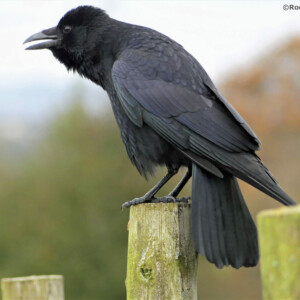
RAVEN CALLING OUT ACROSS THE FIELDS
If you walk down the farm track that leads from Shelf Hall Park to the woods, you’re almost certain to spot carrion crows in the fields on either side. They’re alert, wary birds that don’t normally allow you to get close. But, occasionally, you come across a bird that’s similar but far larger, shaggier and altogether bolder – a raven. This big bruiser was balanced on a fence post and surveying the fields with a distinctly proprietorial air. It wasn’t spooked when I came close, and carried on croaking out its call while rocking up and down.
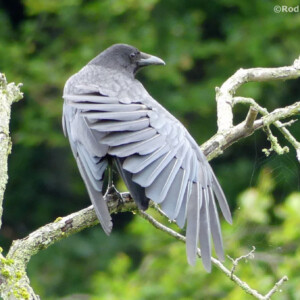
RAVEN PREENING WING
Birds’ wings are a wonder of natural precision engineering.
It’s often difficult to get a good enough view to appreciate quite how amazing they are – but this raven gave me an opportunity by stretching out while preening.
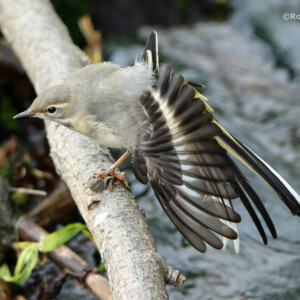
GREY WAGTAIL PREENING
Here’s another, much smaller, bird also stretching out its wing to have a good preen.
This is a grey wagtail, which seemed completely unconcerned as I spent several minutes photographing its beauty regime next to the River Calder in Brighouse.
It’s standing on one foot while scratching with the other. If you look carefully, you can see a toe and claw between two of its wing feathers.
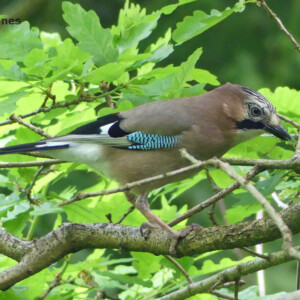
JAY IN AN OAK TREE
In many ways, I find jays infuriating birds. If you can manage to get close enough, their striking markings and beady-eyed Corvid intelligence make them great subjects for photos. But they’re also extremely wary, and we invariably end up locked in an unequal game of hide-and-seek in the woods, where the best I can hope for is a distant glimpse of a white rump vanishing among the branches. This is one of the few occasions when one has let its guard down, allowing me to capture its image among an oak tree’s bright green leaves on a morning in May.
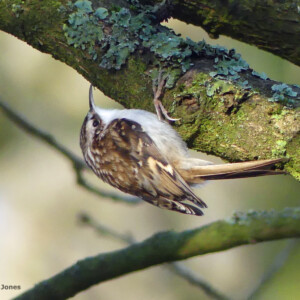
UPSIDE-DOWN TREECREEPER
Treecreepers are unassuming, mousy little birds – until you get close enough to realise that they’re actually impressive athletes. You’re most likely to spot them climbing up a tree trunk – unlike nuthatches, which walk both up and down. This shot from Shelf Hall Park shows a treecreeper in a more unconventional manoeuvre, walking upside down along a horizontal tree branch, hunting for insects. It can achieve this gymnastic feat thanks to its huge, curved toes and long tail, which it uses for balance.
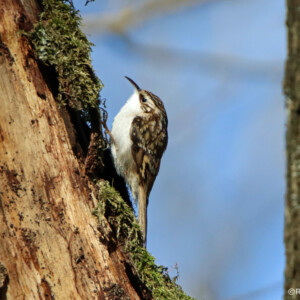
TREECREEPER AGAINST BLUE SKY
Here’s another treecreeper – climbing straight up a mossy tree trunk this time. It’s a sunny morning in early spring, and the bird shows up well against the blue sky.
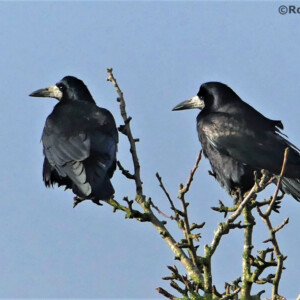
YON TWO ROOKS
There’s a Mark Knopfler song called Yon Two Crows, all about a farmer’s struggle to survive against the odds. It sprang to mind when I came across this wise-looking pair watching the world go by from the very top of a tree in farmland between Shelf and Norwood Green one January morning. These two are rooks – fellow members of the Corvid family distinguished by their parchment-like face. Rooks are intelligent, sociable birds and I like this pair’s air of calm, knowing togetherness.
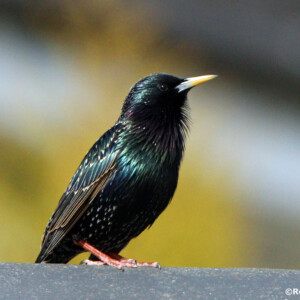
STARLING SHOWING IRIDESCENT COLOURS
There are more than three million starlings in the UK. We often see them as part of squabbling groups or even huge murmurations. But it’s worth focusing on an individual bird – like this one just outside our window – to appreciate the beauty of its iridescent plumage. And – just in case we’re tempted to take them for granted – don’t forget that their numbers have dropped by 66 per cent in Britain since the mid-1970s.
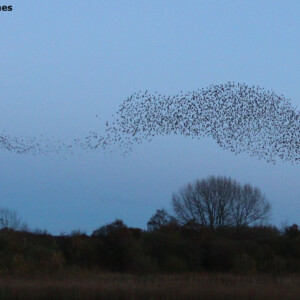
STARLING MURMURATION
Here are some more starlings…a lot more. They’re among tens of thousands which form huge swirling gatherings, known as murmurations, in the skies above Potteric Carr nature reserve in autumn and winter. They create spectacular shapes…I like to imagine this as a lizard or a tadpole.
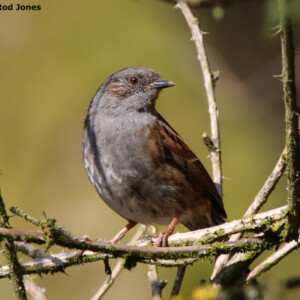
DUNNOCK IN FRAME OF BRANCHES
Twigs and branches are often the bane of the nature photographer’s life: you can pretty well guarantee that your perfectly-framed shot will be ruined when the bird hops behind one just as you press the shutter.
Occasionally, though, branches can add to your shot, creating a natural wooden picture frame, as with this photo of a bright-eyed dunnock in our local woods in spring.

MALE GREAT SPOTTED WOODPECKER LOOKING UP
If you hear a tap-tap-tapping in the woods, the chances are that it’s a great spotted woodpecker drumming on a tree trunk.
These birds are common but quite shy. If you get close enough, you can tell the sexes apart by the patch of red on the back of the male’s head.

FLEDGLING GREAT SPOTTED WOODPECKER LOOKING OUT OF NEST
Young great spotted woodpeckers have an eye-catching red crown, which they lose as they reach maturity.
This one was being pretty obtrusive – calling loudly and leaning precariously out of a hole in a tree trunk in our local woods, clearly ready to fly the nest.
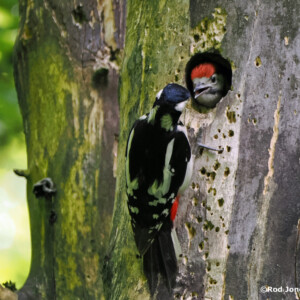
GREAT SPOTTED WOODPECKER CHICK BEING FED BY MOTHER
Here’s another young great spotted woodpecker, looking out of the nest hole as its mother arrives with food.
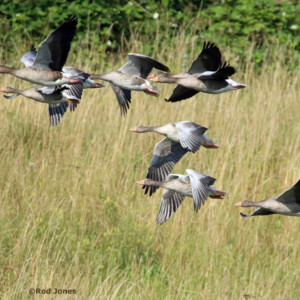
GREYLAG GEESE IN FLIGHT
Geese can look a bit mundane on the ground, but they really come to life when you see them in flight.
This low-flying squadron of greylags shot past me at North Cave Wetlands. You’ve got to marvel at the skill that enables them to fly so fast and so close together.
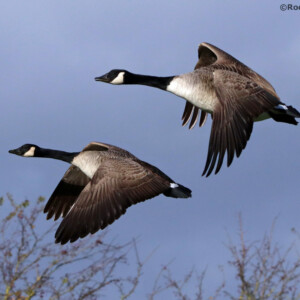
TWO CANADA GEESE IN FLIGHT
Here are two more geese – Canada geese this time – flying close to each other on a sunny autumn morning at RSPB St Aidan’s.
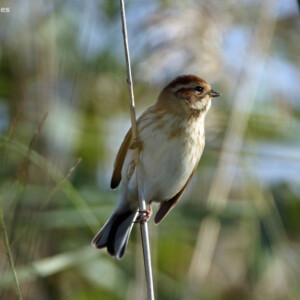
FEMALE REED BUNTING
Sometimes you can spend ages waiting in vain to get a shot of a particular bird, and at other times one just shows up and poses perfectly.
This was one of the latter occasions, at North Cave Wetlands. I heard a rustling noise, swung the camera round and spotted a beautiful female reed bunting a few metres away. She only stayed for a few seconds, but I love her look of concentration as she clings onto the reed, like a sailor searching for land.
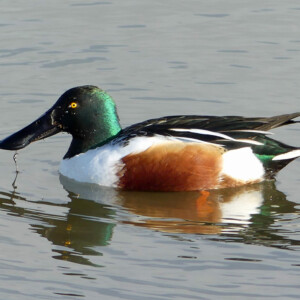
MALE SHOVELER AT OLD MOOR
Shovelers are among my favourite ducks. The males have shiny green heads with bright yellow eyes, and their bodies are a gaudy mixture of white, chestnut, black and green. And what the RSPB describes as their “huge spatulate bills” make them pretty unmistakable. This one, at RSPB Old Moor in Yorkshire’s Dearne Valley, had been searching for food underwater – as you can see from the weed dangling from its bill and the drops of water on its head.
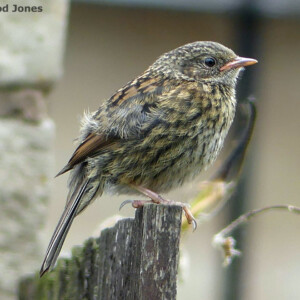
DUNNOCK FLEDGLING IN THE GARDEN
Fledglings – like this young dunnock – often sport a rather gaudy patchwork quilt that hasn’t settled down into their more sober adult plumage. Dunnocks can be relied to visit our suburban garden all year round, and it’s a bonus when they breed successfully.
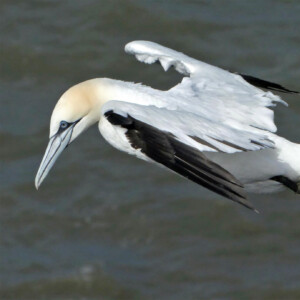
AERODYNAMIC GANNET
RSPB Bempton Cliffs is a seabird city. Nearly half a million of them pack onto the vertiginous cliff edges on the Yorkshire coast near Bridlington each year to breed. One of the star species is Britain’s largest seabird, the gannet. My photos were taken on a course run by award-winning wildlife photographer Steve Race, who knows the best spots on the cliffs to capture gannets’ aerodynamic displays as they hang in the wind.
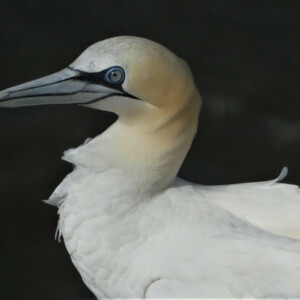
GANNET PORTRAIT
This is another gannet image from RSPB Bempton Cliffs, showing the seabird’s striking eye-pattern and pure white plumage as it rests on the clifftop.

MISTLE THRUSH SINGING
Clear blue sky, and a mistle thrush really letting rip with a wide open-beaked song. This could be a May morning, but the berries give it away. The photo was actually taken on an unusually bright day in the often gloomy month of November in the hawthorn trees next to the farm track that leads down to Shelf Woods.
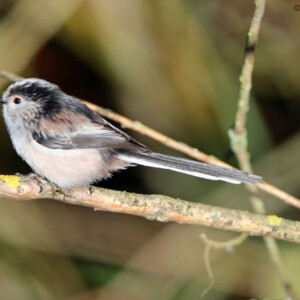
LONG TAILED TIT CLOSE-UP
Long tailed tits are sociable birds usually seen in flocks. They’re pretty common but quite hard to photograph as they flit through the trees and are often hidden by leaves.
This one gave me a rare clear view as it posed for a few moments at Rodley Nature Reserve.
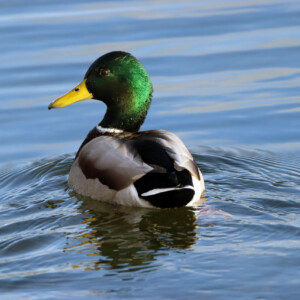
MALLARD DRAKE IN AUTUMN SUNLIGHT
Mallards are the UK’s commonest ducks, and they show up on most of our local lakes and rivers.
This one was swimming on a lake at RSPB St Aidan’s on an autumn morning that showed off its bold colour scheme in the best light.
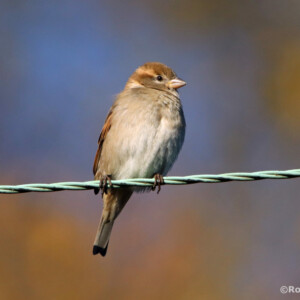
FEMALE HOUSE SPARROW IN AUTUMN SUNLIGHT
House sparrows are easily written off as nondescript little brown birds. But if you catch them in the right light – as on this sunny day in late autumn – they’re actually rather beautiful.
And, if you’re still tempted to take them for granted, you might be shocked to discover that they’re on the conservation red list in the UK after their numbers fell by more than 70 per cent between 1977 and 2008.
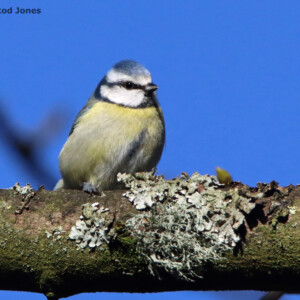
BLUE TIT ON BRANCH WITH LICHEN
Different varieties of lichen and moss can be found in our local woodland in Halifax. Here’s some adding extra colour and interest to a photo of a bright-eyed blue tit in winter sunshine.
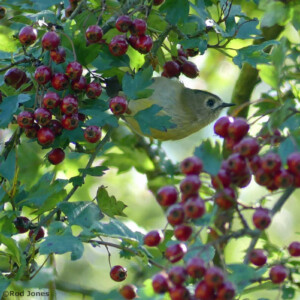
GOLDCREST AMONG HAWTHORN BERRIES
Here’s another goldcrest darting quickly among the berries and leaves of a hawthorn tree in early autumn.
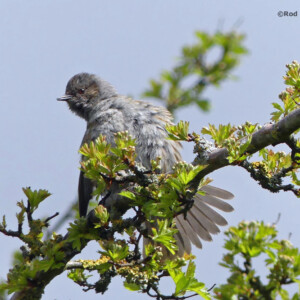
DUNNOCK FANNING OUT ITS TAIL
This dunnock is one of the friendliest birds I’ve ever photographed.
It was perched on a hawthorn branch near the car park at Yorkshire Wildlife Trust’s Stirley Community Farm near Huddersfield. Like robins, dunnocks can be very “confiding,” and this one seemed to enjoy fanning out its tail and putting on a bit of a song and dance routine.
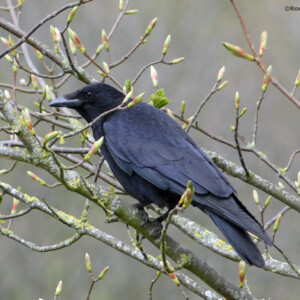
CARRION CROW AMONG SPRING BUDS
I know crows aren’t universally popular, but I rather like their wary intelligence. In the right setting, they can be rather handsome too.
Here’s one showing off its jet black feathers to good effect among the spring buds on a farm track in Shelf.
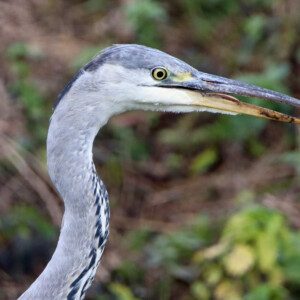
JUVENILE HERON HUNTING IN FIELD
This shot shows a grey heron in stealthy killer mode.
Herons are usually seen standing stock-still next to water, but this bird had left the nearby River Aire and was creeping silently through a field at Rodley Nature Reserve, hunting for prey. You wouldn’t want to be a vole or a frog…
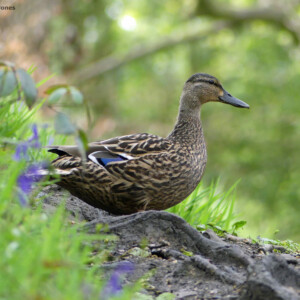
FEMALE MALLARD AMONG BLUEBELLS
Almost half the world’s bluebells are found in the UK, and for a few weeks in April and May whole swathes of our local woods are carpeted with these beautiful flowers.
A waterfowl isn’t necessarily a bird you’d expect to stumble across on a woodland path, but I like the way this female mallard’s blue speculum blends in with the flowers.
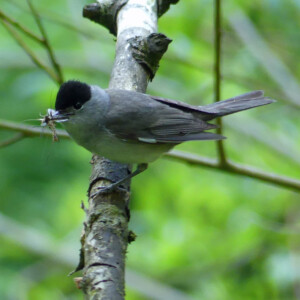
MALE BLACKCAP WITH INSECT PREY
Male blackcaps – as their name suggests – look as though they’re wearing black woolly hats (females have sandy brown headgear instead).
They migrate from southern Europe or north Africa to nest in our local woods. I usually hear their beautiful song first, and then struggle to spot a tiny bird out of camera range and obscured by leaves at the top of a tree.
This one came down to a much lower level, possibly to bring its beakful of insects to its hungry chicks.
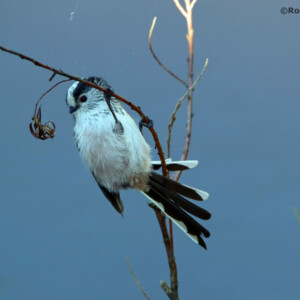
ACROBATIC LONG TAILED TIT
Members of the tit family are natural acrobats.
Here’s a long tailed tit doing a spot of gymnastics at Rodley Nature Reserve. The shot was taken looking down from a bridge, and the blue background is actually the River Aire, rather than the sky.
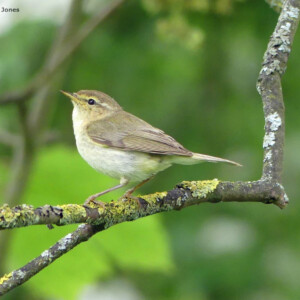
CHIFFCHAFF ON LICHEN BRANCH
Here’s another shot of a chiffchaff, pausing for a second as it flits through a sycamore tree in search of insects in early summer.
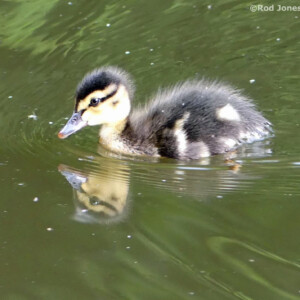
MALLARD DUCKLING WITH REFLECTION
This mallard chick was only a few days old, but it showed a fair turn of speed as it scooted around the canal in Brighouse alongside its mum.
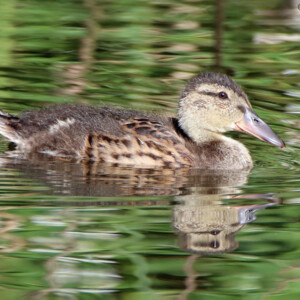
MALLARD DUCKLING AMONG GREEN REFLECTIONS
Here’s another mallard duckling in the same location – but a couple of months later, in high summer.
This duckling is older and bigger than the previous one, and summer’s vivid green hues are reflected in the waters of the canal.
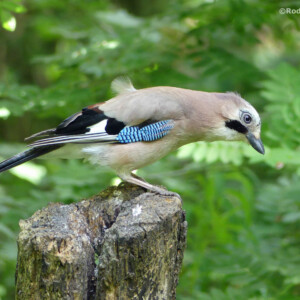
JAY ON TREE STUMP
Here’s another shot of a jay – dropping in at the feeding station at Cromwell Bottom. I hope the image reflects its character – crafty, wary and inquisitive.
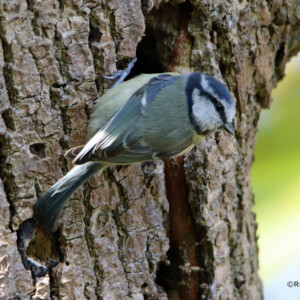
BLUE TIT NEXT TO HOLE IN TREE TRUNK
Birdwatchers describe some individual birds as particularly “confiding” – and this blue tit certainly fell into that category.
It seemed pretty unconcerned about my presence as I stood a couple of metres away, photographing its trips into a hole in a tree trunk in search of insects on an autumn day.
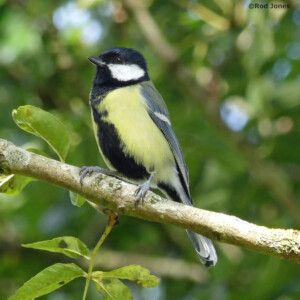
GREAT TIT IN AUTUMN SUNLIGHT
Warm sunlight and a green background help to show many birds’ colours off to good effect, as with this great tit.
This photo was taken in mid-September, just before the green leaves begin to take on autumnal hues.
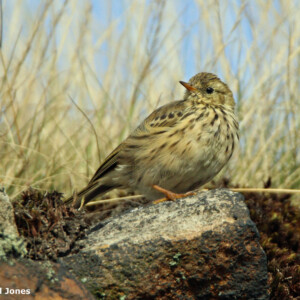
MEADOW PIPIT ON MOORLAND
In the many hours I’ve spent looking for rare twites in the Pennines, I’ve seen an awful lot of fairly similar streaky brown birds.
Meadow pipits – like this one perched next to a footpath – are the commonest songbirds of upland areas.

MEADOW PIPIT HAVING A BATH
Here’s another meadow pipit in the high Pennines – enjoying a cool dip on a sunny day.
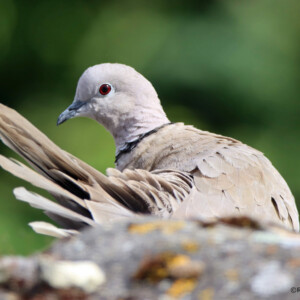
COLLARED DOVE PREENING ON HOUSE ROOF
Sometimes photographing birds can help you notice new things about them.
Collared doves are pretty common. They’re fairly frequent visitors to our garden. I’ve always regarded them as woodpigeons’ daintier and more elegant cousins. But until I focused my telephoto lens on them – like this one preening outside our bedroom window – I didn’t appreciate what lovely ruby red eyes they’ve got.
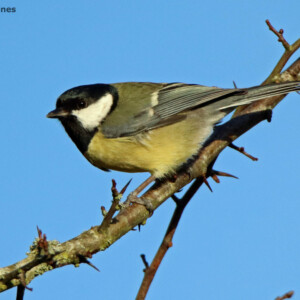
GREAT TIT IN JANUARY SUNSHINE
A bit of sunshine – even in the depths of winter – can make it feel as though spring isn’t too far away.
The birds seem to sense it too. This great tit was among a group flitting about excitedly and calling to each other on a sunny day in early January.
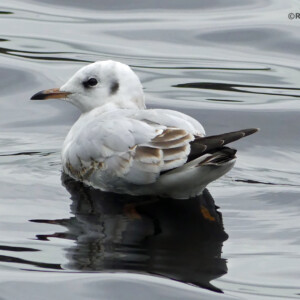
BLACK HEADED GULL ON GREY WATER
There isn’t a lot of bright colour in this photo, and I think the overall effect is quite chilly.
In summer, these gulls have chocolate-brown heads, but this is the less striking winter plumage. Combine it with the grey water, and you feel you’re in the depths of winter.
It was actually taken in mid-September at Ogden Water in Halifax.
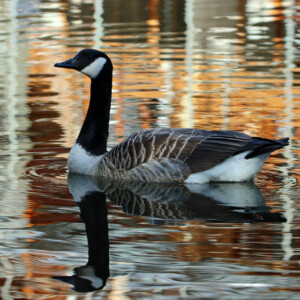
CANADA GOOSE ON GOLDEN WATER
There’s a much warmer feel to this photo taken on the canal in Brighouse.
It’s a sunny day in early April, and the water takes on a golden hue as a Canada goose swims through it.
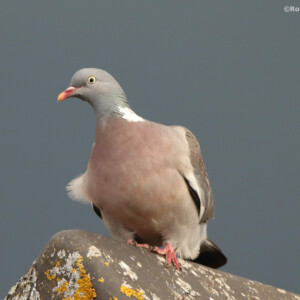
WOODPIGEON IN APPROACHING STORM
Summer sometimes brings torrential downpours to West Yorkshire, and this photo captures one of those occasions.
A woodpigeon perches on a house roof. A sudden wind ruffles its feathers. Behind it, the sky turns an ominous shade of grey. It’s going to get soaked.
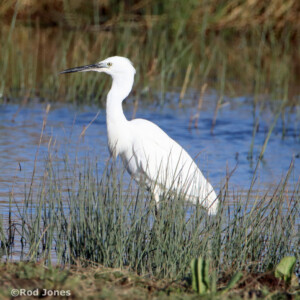
LITTLE EGRET FISHING IN WETLANDS
If you crossed a swan with a heron, you might come up with something like a little egret. They’ve got attractive, snowy white plumage, coupled with a long neck and dagger-like bill.
They’re a fairly common sight on England’s south coast, but rarer further north. This one was fishing in the wetlands at RSPB St Aidan’s.
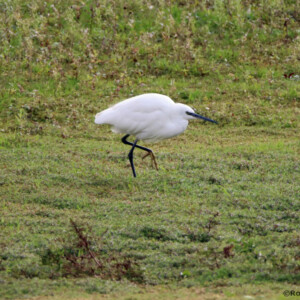
LITTLE EGRET TIPTOEING THROUGH FIELD
Here’s another little egret, hunting on land this time at North Cave Wetlands.
I like the cartoonish pose as it tiptoes stealthily through a field in search of prey.

LITTLE EGRET IN FLIGHT
Little egrets are a wonderful sight when they take to the air, with their beautifully patterned white wings and their long legs trailing behind them.
This one was flying over the reedbeds at RSPB St Aidan’s.
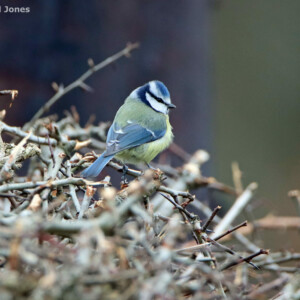
BLUE TIT ON TOP OF HEDGE
The dark background shows off this blue tit’s beautifully coloured plumage to good effect as it perches on a hedge in farmland in early spring.
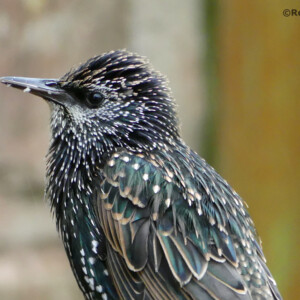
STARLING CLOSE-UP
On a rainy day in late September, a noisy gaggle of dozens of squabbling starlings descended on our neighbourhood. Many headed for the bird feeders in our garden, while others watched from nearby roofs.
Thousands of starlings migrate to the UK in autumn from colder climes in Eastern Europe , and our visitors – including this handsome individual – were probably stopping for a spot of refuelling on their journey west.
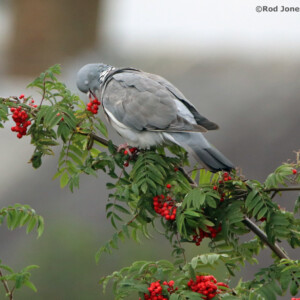
WOODPIGEON EATING ROWAN BERRIES
In September 2021 I was holed up in our spare bedroom for ten days of self-isolation after catching Covid.
I opened the windows as wide as possible and spent hours watching and photographing our garden birds.
This is one of my favourite shots – a woodpigeon savouring a bunch of juicy red rowan berries.

FEMALE SCAUP AFTER DIVING
Scaups are the UK’s rarest breeding ducks. You’re more likely to see them in autumn and winter – like this female on one of the lakes at North Cave Wetlands.
She’s quite a striking sight, with her bright yellow eye and the water droplets from repeated dives glistening on her chestnut plumage.
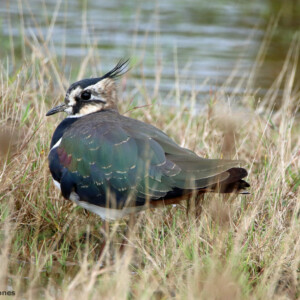
LAPWING AMONG LONG GRASS
When I was growing up, lapwings were common and familiar birds. We’d hear their distinctive “peewit” cries and watch them wheeling and tumbling through the sky anywhere vaguely rural.
But their numbers plummeted by 49 per cent between 1987 and 1998 as their habitat was hit by changes to farming methods.
They’re on the red list of endangered species, so it’s good to see places where they’re given the conditions they need to thrive – as here at RSPB St Aidan’s.
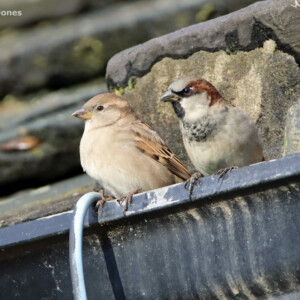
HOUSE SPARROW COUPLE
Mr and Mrs House Sparrow, sitting on their balcony, watching the world go by…
I like the feeling of togetherness in this photo, making them look like an old married couple.
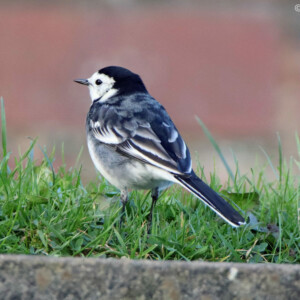
PIED WAGTAIL AGAINST RED BACKGROUND
Some backgrounds contrast well with a bird’s colours and show them off to good effect.
I like the way the black and white plumage of this pied wagtail stands out against one of the red brick walls at the Temple Newsam estate in Leeds.

PIED WAGTAIL AGAINST BROWN BACKGROUND
Here’s another pied wagtail standing out well, against a brown background this time. This engaging bird distracted me briefly while I was photographing twites in the high Pennines.
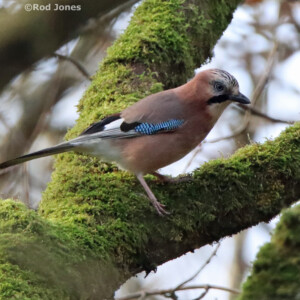
JAY IN MOSSY TREE FORK
Jays are particularly active in autumn, when they fly squawking around our local woods in search of food to stash for winter.
This makes them slightly less wary than usual – like this one pausing briefly in a mossy tree fork.

DUNNOCK AMONG AUTUMN GUELDER ROSE LEAVES
I like images that show birds in their natural environment – like this one of a dunnock basking in autumn sunshine among the pinks and greens of guelder rose leaves.
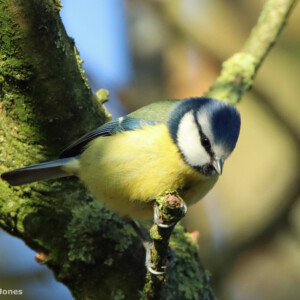
BLUE TIT IN WINTER SUNSHINE
In the depths of winter there’s precious little daylight, and the Yorkshire weather can be gloomy. But winter sunshine – when the sun is low in the sky – casts a magical spell all of its own.
This photo – of a blue tit flitting about in a tree in our local park – was taken not long after sunrise (about 9am) on a glorious December morning.
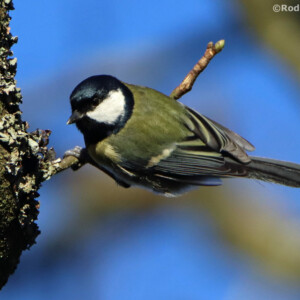
BACK VIEW OF GREAT TIT IN WINTER SUNSHINE
Here’s another image from the same gorgeous December morning – a great tit’s olive green, yellow, black and white plumage showing up well in the winter sunlight.
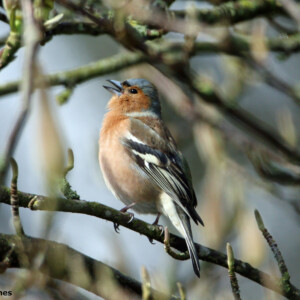
MALE CHAFFINCH AMONG SPRING BUDS
Male chaffinches are among the most enthusiastic and noticeable singers in our local woods and park.
Here’s one braving snow and freezing temperatures to belt out a tune in late March.
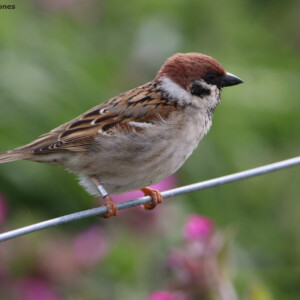
TREE SPARROW PERCHING ON WIRE
The gannets and puffins may be the stars of the RSPB’s Bempton Cliffs reserve, but the sparrows are worth a look too.
They’re tree sparrows, who can be told apart from their commoner house sparrow cousins by their black cheek patches and white collars.
Tree sparrow numbers in the UK have dropped by more than 90 per cent over the past half century. Birds like this one have been fitted with rings to help the RSPB track their movements in an attempt to halt the decline.
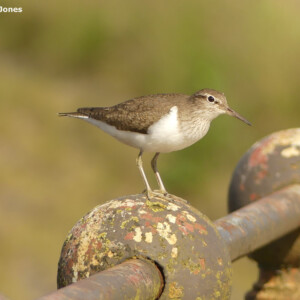
COMMON SANDPIPER ON RUSTY BRIDGE
I do my RSPB volunteering in the high Pennines, where it’s often wet and windy. That wild weather creates an environment with plenty of water to attract wading birds.
And it makes it more of a treat when the sun actually shines – as it did on a June morning, bathing this common sandpiper in gorgeous light as it watched me from a rusty bridge.
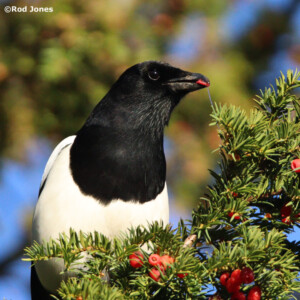
MAGPIE EATING YEW FRUIT
One of the highlights of my local park is the lofty yew tree that stands between the bowling green and the tennis courts.
In autumn its dark green branches are adorned with red fruits (which technically speaking aren’t berries, even though they look very similar). These are a magnet for lots of different birds.
Here’s a magpie snacking on them on a bright November morning. If you look closely, you can see a thin trail of juice dripping out of the fruit.
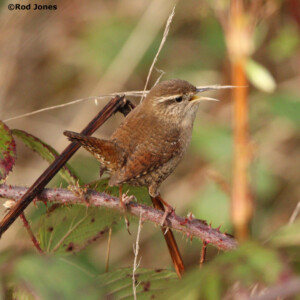
WREN CALLING ON BRAMBLE BRANCH
Wrens may be tiny, but their voice really packs a punch. This one was blasting out a salvo of loud calls while turning vigorously from side to side on a bramble branch on a sunny morning in November.
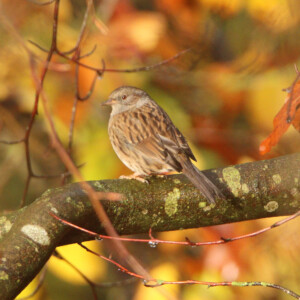
DUNNOCK IN AUTUMN BEECH TREE
Beeches are some of the commonest – and most beautiful – trees in our local woods. In autumn, their leaves turn a gorgeous mixture of gold, yellow, orange and green – providing a colourful backdrop for this dunnock.



